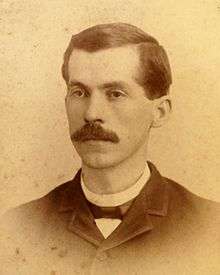Archibald Hill Carmichael
| Archibald Hill Carmichael | |
|---|---|
 | |
| Member of the U.S. House of Representatives from Alabama's 8th district | |
|
In office November 14, 1933 – January 3, 1937 | |
| Preceded by | Edward B. Almon |
| Succeeded by | John Sparkman |
| Member of the Alabama Senate from the 31st district | |
|
In office January 14, 1919 – January 10, 1923 | |
| Preceded by | W. H. Key |
| Succeeded by | John P. Middleton |
| Speaker of the Alabama House of Representatives | |
|
In office January 12, 1915 – January 14, 1919 | |
| Preceded by | Edward B. Almon |
| Succeeded by | Henry P. Merritt |
|
In office February 26, 1907 – January 10, 1911 Pro tempore: February 26, 1907 – March 4, 1907 | |
| Preceded by | William L. Martin |
| Succeeded by | Edward B. Almon |
| Member of the Alabama House of Representatives from Colbert County | |
|
In office January 12, 1915 – January 14, 1919 | |
| Preceded by | Edward B. Almon |
| Succeeded by | W. H. Shaw |
|
In office January 8, 1907 – January 10, 1911 | |
| Succeeded by | Edward B. Almon |
| Personal details | |
| Born |
Archibald Hill Carmichael June 17, 1864 Sylvan Grove, Alabama, U.S. |
| Died |
July 15, 1947 (aged 83) Tuscumbia, Alabama, U.S. |
| Political party | Democratic |
| Spouse(s) | Annie Sugg |
| Alma mater | University of Alabama |
Archibald Hill Carmichael (June 17, 1864 – July 15, 1947) was an American Democratic politician who represented Alabama's 8th congressional district in the United States House of Representatives from November 1933 to January 1937.
Early life
Archibald Hill Carmichael was born in Dale County, Alabama, near the community of Sylvan Grove. His father, Jesse Malcolm Carmichael, who fought in the Civil War and lost a hand at the Battle of Antietam, served as Alabama Secretary of State.[1] The younger Carmichael received his education in public schools and studied at the University of Alabama School of Law, graduating in 1886. He was admitted to the bar that same year and moved to north Alabama to practice law in Tuscumbia.[2] Carmichael married Annie Sugg in 1890.[3]
Political life
Carmichael served four years (1890–1894) as solicitor for the 8th judicial district of Alabama. In 1901 he was a delegate to the Alabama state constitutional convention. It was this convention which drafted the Alabama constitution presently in use in Alabama today and which is one of the longest such documents in the world. Carmichael served in the Alabama House of Representatives from 1907 until 1911 and then again from 1915 until 1919. During those tenure's he served as the Speaker of the House in 1907 and 1911. Active in partisan politics Carmichael was a delegate to the Democratic National Convention in 1916, 1928 and 1932.[2]
School boards
Carmichael was active in both state and local education issues. In fact, he held three elected positions at the same time. He was elected to the Alabama State Senate from 1919 to 1923; the Alabama State Board of Education from 1919 to 1947 and the local Tuscumbia Board of Education from 1920 to 1947. During that same period, he was appointed as a trustee of the University of Alabama from 1924 to 1947.[2]
U.S. Congress
Carmichael's first election to the U.S. House of Representatives came on November 7, 1933 when he was elected to fill the unexpired term of Edward B. Almon who had died while in office. Carmichael was elected to a full term in the 74th Congress serving from 1935 to 1937. During this session, the Social Security Act became law. He did not seek re-election, returning, instead, to Alabama, where he continued to practice law until his death.[2]
Archibald Hill Carmichael died in Tuscumbia at the age of 83.
References
- Alabama Legislative History Overview,[1] Accessed 19 April 2007.
- Biographical Directory of the United States Congress "Archibald Hill Carmichael", Accessed 19 April 2007.
- Brant & Fuller Colbert County Alabama Archives and Biographies - Archibald Hill Carmichael, Accessed via rootsweb.com on 19 April 2007.
Notes
- 1 2 Welcome to the Alabama State Legislature Archived April 23, 2007, at the Wayback Machine.
- 1 2 3 4 United States Congress. "CARMICHAEL, Archibald Hill (id: C000159)". Biographical Directory of the United States Congress.
- ↑ http://ftp.rootsweb.com/pub/usgenweb/al/colbert/bios/gbs305carmicha.txt
| U.S. House of Representatives | ||
|---|---|---|
| Preceded by Edward B. Almon |
Member of the U.S. House of Representatives from Alabama's 8th congressional district 1933–1937 |
Succeeded by John J. Sparkman |
